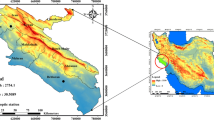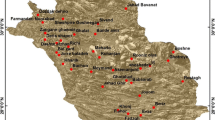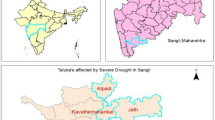Abstract
The search for better climate change adaptation techniques for addressing environmental and economic issues due to changing climate is of paramount interest in the current era. One of the many ways Pacific Island regions and its people get affected is by dry spells and drought events from extreme climates. A drought is simply a prolonged shortage of water supply in an area. The impact of drought varies both temporally and spatially that can be catastrophic for such regions with lack of resources and facilities to mitigate the drought impacts. Therefore, forecasting drought events using predictive models that have practical implications for understanding drought hydrology and water resources management can allow enough time to take appropriate adaption measures. This study investigates the feasibility of the Artificial Neural Network (ANN) algorithms for prediction of a drought index: Standardized Precipitation-Evapotranspiration Index (SPEI). The purpose of the study was to develop an ANN model to predict the index in two selected regions in Queensland, Australia. The first region, is named as the grassland and the second as the temperate region. The monthly gridded meteorological variables (precipitation, maximum and minimum temperature) that acted as input parameters in ANN model were obtained from Australian Water Availability Project (AWAP) for 1915–2013 period. The potential evapotranspiration (PET), calculated using thornthwaite method, was also an input variable, while SPEI was the predictand for the ANN model. The input data were divided into training (80%), validation (10%) and testing (10%) sets. To determine the optimum ANN model, the Levenberg-Marquardt and Broyden-Fletcher-Goldfarb-Shanno quasi-Newton backpropagation algorithms were used for training the ANN network and the tangent sigmoid, logarithmic sigmoid and linear activation algorithms were used for hidden transfer and output functions. The best architecture of input-hidden neuron-output neurons was 4-28-1 and 4-27-1 for grassland and temperate region, respectively. For evaluation and selection of the optimum ANN model, the statistical metrics: Coefficient of Determination (R 2 ), Willmott’s Index of Agreement (d), Nash-Sutcliffe Coefficient of Efficiency (E), Root Mean Squared Error (RMSE) and Mean Absolute Error (MAE) were employed. The R 2 , d, E, RMSE and MAE for optimum ANN models were 0.9839, 0.9909, 0.9838, 0.1338, 0.0882 and 0.9886, 0.9935, 0.9874, 0.1198, 0.0814 for grassland and temperate region, respectively. When prediction errors were analysed, a value of 0.0025 to 0.8224 was obtained for the grassland region, and a value of 0.0113 to 0.6667 was obtained for the temperate region, indicating that the ANN model exhibit a good skill in predicting the monthly SPEI. Based on the evaluation and statistical analysis of the predicted SPEI and its errors in the test period, we conclude that the ANN model can be used as a useful data-driven tool for forecasting drought events. Broadly, the ANN model can be applied for prediction of other climate related variables, and therefore can play a vital role in the development of climate change adaptation and mitigation plans in developed and developing nations, and most importantly, in the Pacific Island Nations where drought events have a detrimental impact on economic development.
Access this chapter
Tax calculation will be finalised at checkout
Purchases are for personal use only
Similar content being viewed by others
Abbreviations
- ANN:
-
Artificial Neural Networks
- AWAP:
-
Australian Water Availability Project
- BFGS quasi-Newton:
-
Broyden-Fletcher-Goldfarb-Shanno quasi-Newton
- d :
-
Willmott’s Index of Agreement
- E :
-
Nash-Sutcliffe Coefficient of Efficiency
- LM:
-
Levenberg-Marquardt training algorithm
- Logsig :
-
Logarithmic sigmoid
- MAE :
-
Mean Absolute Error
- NRM:
-
Natural Resource Management
- PE:
-
Prediction Error
- PET:
-
Potential Evapotranspiration
- Q1:
-
First quartile (25th percentile)
- Q2:
-
Second quartile (50th percentile or median)
- Q3:
-
Third quartile (75th percentile)
- R 2 :
-
Coefficient of Determination
- RMSE :
-
Root Mean Squared Error
- SPEI:
-
Standardized Precipitation-Evapotranspiration Index
- Tansig :
-
Tangent sigmoid
- Trainbfg :
-
Training BFGS quasi-Newton
- Trainlm :
-
Training Levenberg-Marquardt
References
Abbot, J., & Marohasy, J. (2012). Application of artificial neural networks to rainfall forecasting in Queensland, Australia. Advances in Atmospheric Sciences, 29(4), 717–730.
Abbot, J., & Marohasy, J. (2014). Input selection and optimisation for monthly rainfall forecasting in Queensland, Australia, using artificial neural networks. Atmospheric Research, 138, 166–178.
Acharya, N., Shrivastava, N. A., Panigrahi, B., & Mohanty, U. (2013). Development of an artificial neural network based multi-model ensemble to estimate the northeast monsoon rainfall over south peninsular India: An application of extreme learning machine. Climate Dynamics, 43(5), 1303–1310.
Arora, V. K. (2002). The use of the aridity index to assess climate change effect on annual runoff. Journal of Hydrology, 265(1), 164–177.
Day, K., Ahrens, D., & Peacock, A. (2010), Seasonal Pacific Ocean Temperature Analysis-1 (SPOTA-1) as at November 1, 2010 (2 pp). Report issued by the Queensland Climate Change Centre of Excellence, Queensland Government, Brisbane, Australia. Retrieved from https://www.longpaddock.qld.gov.au/spota1-getpassword.html.
Dennis, J. E., & Schnabel, R. B. (1983). Numerical methods for unconstrained minimization. Englewood Cliffs: Prentice-Hall.
Deo, R. C., & Şahin, M. (2015a). Application of the extreme learning machine algorithm for the prediction of monthly Effective Drought Index in eastern Australia. Atmospheric Research, 153, 512–525. item: WOS:000347264600041.
Deo, R. C., & Şahin, M. (2015b). Application of the artificial neural network model for prediction of monthly standardized precipitation and evapotranspiration index using hydrometeorological parameters and climate indices in eastern Australia. Atmospheric Research, 161, 65–81.
Deo, R. C., Samui, P., & Kim, D. (2015). Estimation of monthly evaporative loss using relevance vector machine, extreme learning machine and multivariate adaptive regression spline models. Stochastic Environmental Research and Risk Assessment, 30, 1–16.
Dogan, S., Berktay, A., & Singh, V. P. (2012). Comparison of multi-monthly rainfall-based drought severity indices, with application to semi-arid Konya closed basin, Turkey. Journal of Hydrology, 470–471, 255–268.
Hagan, M. T., & Menhaj, M. B. (1994). Training feedforward networks with the Marquardt algorithm. IEEE Transactions on Neural Networks, 5(6), 989–993.
Hanson, R. L. (1988). Evapotranspiration and droughts (pp. 99–104). Paulson, RW, Chase, EB, Roberts, RS, and Moody, DW, Compilers, National Water Summary.
Hargreaves, G. H. (1994). Defining and using reference evapotranspiration. Journal of Irrigation and Drainage Engineering, 120(6), 1132–1139.
Hudson, D., Alves, O., Hendon, H. H., & Marshall, A. G. (2011). Bridging the gap between weather and seasonal forecasting: intraseasonal forecasting for Australia. Quarterly Journal of the Royal Meteorological Society, 137(656), 673–689.
Inquiry, QFCo, & Holmes, CE. (2012). Queensland Floods Commission of Inquiry: Final Report. Queensland Floods Commission of Inquiry.
Krause, P., Boyle, D., & Bäse, F. (2005). Comparison of different efficiency criteria for hydrological model assessment. Advances in Geosciences, 5(5), 89–97.
Kuligowski, R. J., & Barros, A. P. (1998). Experiments in short-term precipitation forecasting using artificial neural networks. Monthly Weather Review, 126(2), 470–482.
Marquardt, D. W. (1963). An algorithm for least-squares estimation of nonlinear parameters. Journal of the Society for Industrial and Applied Mathematics, 11(2), 431–441.
McCulloch, W. S., & Pitts, W. (1943). A logical calculus of the ideas immanent in nervous activity. The Bulletin of Mathematical Biophysics, 5(4), 115–133.
McCulloch, W. S., & Pitts, W. (1990). A logical calculus of the ideas immanent in nervous activity. Bulletin of Mathematical Biology, 52(1–2), 99–115.
Mekanik, F., Imteaz, M., Gato-Trinidad, S., & Elmahdi, A. (2013). Multiple regression and Artificial Neural Network for long-term rainfall forecasting using large scale climate modes. Journal of Hydrology, 503, 11–21.
Monteleoni, C., Schmidt, G. A., Saroha, S., & Asplund, E. (2011). Tracking climate models. Statistical Analysis and Data Mining, 4(4), 372–392.
Morid, S., Smakhtin, V., & Moghaddasi, M. (2006). Comparison of seven meteorological indices for drought monitoring in Iran. International Journal of Climatology, 26(7), 971–985.
Mpelasoka, F., Hennessy, K., Jones, R., & Bates, B. (2008). Comparison of suitable drought indices for climate change impacts assessment over Australia towards resource management. International Journal of Climatology, 28(10), 1283–1292.
Nash, J., & Sutcliffe, J. (1970). River flow forecasting through conceptual models part I—A discussion of principles. Journal of Hydrology, 10(3), 282–290.
NRM. (2015). Climate change in Australia, impacts & adaptation information for Australia’s NRM regions. Commonwealth Scientific and Industrial Research Organisation. Accessed April 01, from http://www.climatechangeinaustralia.gov.au/en/impacts-and-adaptation/central-slopes/.
Pandey, R. P., Dash, B. B., Mishra, S. K., & Singh, R. (2008). Study of indices for drought characterization in KBK districts in Orissa (India). Hydrological Processes, 22(12), 1895–1907.
Paulescu, M., Tulcan-Paulescu, E., & Stefu, N. (2011). A temperature-based model for global solar irradiance and its application to estimate daily irradiation values. International Journal of Energy Research, 35(6), 520–529.
Penman, H. L. (1948). Natural evaporation from open water, bare soil and grass. In Proceedings of the Royal Society of London A: Mathematical, Physical and Engineering Sciences (pp. 120–45). The Royal Society.
Raupach, M., Briggs, P., Haverd, V., King, E., Paget, M., & Trudinger, C. (2008). Australian water availability project (AWAP) (Vol. 2, p. 38). CSIRO Marine and Atmospheric Research Component: Final report for phase.
Reichler, T., & Kim, J. (2008). How well do coupled models simulate today’s climate? Bulletin of the American Meteorological Society, 89(3), 303–311.
Reifen, C., & Toumi, R. (2009). Climate projections: Past performance no guarantee of future skill? Geophysical Research Letters, 36(13), L13704.
Şahin, M. (2012). Modelling of air temperature using remote sensing and artificial neural network in Turkey. Advances in Space Research, 50(7), 973–985.
Şahin, M., Kaya, Y., & Uyar, M. (2013). Comparison of ANN and MLR models for estimating solar radiation in Turkey using NOAA/AVHRR data. Advances in Space Research, 51(5), 891–904.
Thornthwaite, C. W. (1948). An approach toward a rational classification of climate. Geographical Review, 38, 55–94.
Tiwari, M. K., & Adamowski, J. (2013). Urban water demand forecasting and uncertainty assessment using ensemble wavelet-bootstrap-neural network models. Water Resources Research, 49(10), 6486–6507.
Ulgen, K., & Hepbasli, A. (2002). ‘Comparison of solar radiation correlations for Izmir, Turkey. International Journal of Energy Research, 26(5), 413–430.
Vicente-Serrano, S. M., Beguería, S., & López-Moreno, J. I. (2010a). A multiscalar drought index sensitive to global warming: the standardized precipitation evapotranspiration index. Journal of Climate, 23(7), 1696–1718.
Vicente-Serrano, S. M., Beguería, S., López-Moreno, J. I., Angulo, M., & El Kenawy, A. (2010b). A new global 0.5 gridded dataset (1901–2006) of a multiscalar drought index: Comparison with current drought index datasets based on the Palmer Drought Severity Index. Journal of Hydrometeorology, 11(4), 1033–1043.
Vicente-Serrano, S. M., Beguería, S., Lorenzo-Lacruz, J., Camarero, J. J., López-Moreno, J. I., Azorin-Molina, C., et al. (2012). Performance of drought indices for ecological, agricultural, and hydrological applications. Earth Interactions, 16(10), 1–27.
Vicente-Serrano, S. M., Gouveia, C., Camarero, J. J., Beguería, S., Trigo, R., López-Moreno, J. I., et al. (2013). Response of vegetation to drought time-scales across global land biomes. Proceedings of the National Academy of Sciences, 110(1), 52–57.
Vicente‐Serrano, S. M., Beguería, S., & López‐Moreno, J.I. (2011). Comment on “Characteristics and trends in various forms of the Palmer Drought Severity Index (PDSI) during 1900–2008” by Aiguo Dai. Journal of Geophysical Research: Atmospheres, 116, no. D19.
Vogl, T. P., Mangis, J., Rigler, A., Zink, W., & Alkon, D. (1988). Accelerating the convergence of the back-propagation method. Biological Cybernetics, 59(4–5), 257–263.
Willmott, C. J. (1981). On the validation of models. Physical Geography, 2(2), 184–194.
Willmott, C. J. (1982). Some comments on the evaluation of model performance. Bulletin of the American Meteorological Society, 63(11), 1309–1313.
Zhao, M., & Hendon, H. H. (2009). Representation and prediction of the Indian Ocean dipole in the POAMA seasonal forecast model. Quarterly Journal of the Royal Meteorological Society, 135(639), 337–352.
Acknowledgements
The data were acquired from the Australian Water Availability Project (AWAP). Kavina Dayal was supported by the University of Southern Queensland Postgraduate Research Scholarship (USQ-PRS) and School of Computational, Agricultural and Environmental Sciences. We thank the reviewers and editor for their comments and feedback.
Author information
Authors and Affiliations
Corresponding author
Editor information
Editors and Affiliations
Rights and permissions
Copyright information
© 2017 Springer International Publishing AG
About this chapter
Cite this chapter
Dayal, K., Deo, R., Apan, A.A. (2017). Drought Modelling Based on Artificial Intelligence and Neural Network Algorithms: A Case Study in Queensland, Australia. In: Leal Filho, W. (eds) Climate Change Adaptation in Pacific Countries. Climate Change Management. Springer, Cham. https://doi.org/10.1007/978-3-319-50094-2_11
Download citation
DOI: https://doi.org/10.1007/978-3-319-50094-2_11
Published:
Publisher Name: Springer, Cham
Print ISBN: 978-3-319-50093-5
Online ISBN: 978-3-319-50094-2
eBook Packages: Earth and Environmental ScienceEarth and Environmental Science (R0)




